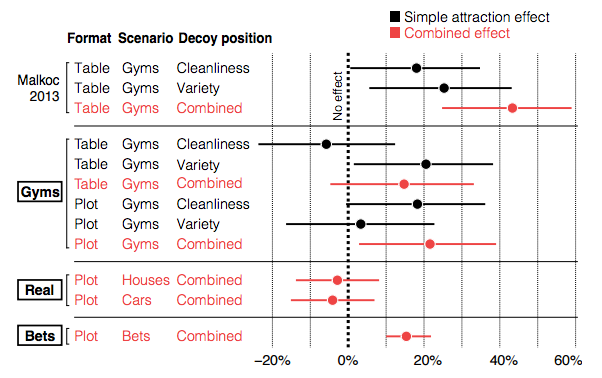The Attraction Effect in Information Visualization - Experimental Material
Evanthia Dimara, Anastasia Bezerianos and Pierre Dragicevic

The attraction effect is a well-studied cognitive bias in decision making research, where one's choice between two alternatives is influenced by the presence of an irrelevant (dominated) third alternative. We examine whether this cognitive bias, so far only tested with three alternatives and simple presentation formats such as numerical tables, also appears in visualizations. Since visualizations can be used to support decision making — e.g., when choosing a house to buy or an employee to hire — a systematic bias could have important implications. We conducted three crowdsourcing experiments to investigate whether the effect generalizes when alternatives are presented as scatterplots.
The first and the third experiment (named "Gyms" and "Bets") provided good evidence for an attraction effect in scatterplots, and are reported in a paper titled "The Attraction Effect in Information Visualization". The second experiment (named "Real") was inconclusive, and is described in a research report titled "Testing the Attraction Effect on Two Information Visualization Datasets".
OSF repository
We created this page in 2016. In 2021, we created an OSF repository where we put most of the material available here, and more: https://osf.io/kfhme/. Here you can however try the experiment directly in your browser, which is not possible with the OSF repository.
Erratum
The TVCG article states that the combined attraction effect can be computed by looking at "the differences between the bars marked “decoy” in Figure 3". It should read "the differences between the two left bars or the two right bars across two decoy conditions in Figure 3".
Thanks to Chat Wacharamanotham for spotting this.
Paper PDFs
- Evanthia Dimara, Anastasia Bezerianos, Pierre Dragicevic. The Attraction Effect in Information Visualization. IEEE TVCG 2017.
- Evanthia Dimara, Anastasia Bezerianos, Pierre Dragicevic. Testing the Attraction Effect on Two Information Visualization Datasets. Inria Research Report 8895.
Conference talk
Stimuli and raw data
Click on the links below and follow instructions.
R code
Contact
License
 | All material on this page is CC-BY-SA. You can reuse or adapt it provided you cite our paper and/or link to www.aviz.fr/decoy. |